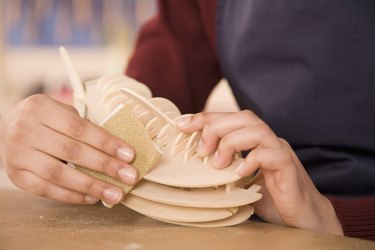Things You'll Need
Sandpaper
Damp cloth
Pull scraper
Orbital sander

Nothing destroys the look of an attractive piece of solid hardwood or wood veneer more quickly than cross-grain scratches. They are often an unavoidable product of a refinishing procedure, and they can occur on floors, furniture or craft items. One of the most common places to find cross-grain scratches is in inside corners where the grain runs perpendicular to the corner. You often can't sand these adequately by going with the grain and have to go cross-grain to remove finish or stain. You can get these and all other scratch marks out with sandpaper or a scraper.
Step 1
Sand out deep cross-grain scratch marks on flat or curved surfaces with coarse sandpaper. If you know the grit of the paper that made the scratches, use the same grit to sand them out. Do the sanding by hand, and work with the grain.
Video of the Day
Step 2
Change the paper to the next finer grit and sand again, going with the grain. For example, if you started with 80-grit paper, change to 100-grit. Wipe the area with damp cloth after you're finished the second sanding and examine the surface. If you can still see scratches highlighted in the moistened wood, change to the next finer grit and sand again. Continue graduating to finer grits until the scratches aren't visible. In most cases, you shouldn't have to sand with paper finer than 180-grit.
Step 3
Remove scratches quickly from corners of floors, cabinets and other solid hardwood woodwork with a pull scraper. Place the scraper blade in the corner and put moderate pressure on it as you pull the scraper toward you along the grain. Sand along the grain with fine paper, such as 150-grit, to clean up after you're finished scraping. Don't use a scraper on veneered surfaces.
Step 4
Erase scratches from inside corners of veneered cabinets by hand sanding. Fold a piece of the same grit paper that made the scratches into three layers and sand with the grain, pushing the paper into the corner of the wood. Change to finer grits of sandpaper as needed, and stop sanding as soon as the scratches are no longer visible.
Step 5
Get out an orbital sander for large jobs, such as stair treads or large, flat surfaces with deep scratches. Sand with increasingly finer grits of sandpaper until the scratches aren't noticeable. Finish up by hand-sanding with the grain, using the finest grit paper you used in the sander.
Tip
If you're sanding a large, flat area, it helps to use a sanding block, which can be simply a two-by-four around which you fold the sandpaper. A store-bought block with an attached foam pad works better, however.
If the scratches come from a belt sander, the best way to remove them is by sanding along the grain with the belt sander. When this isn't possible, use an orbital sander.
Warning
If you're sanding veneer, and the veneer cracks or begins to wear through, stop sanding immediately. At this point, you can either live with the scratches or replace the veneer.
Video of the Day